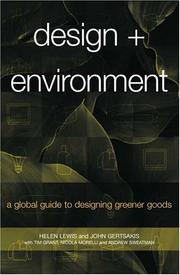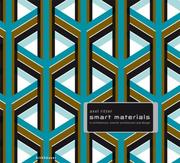| Listing 1 - 3 of 3 |
Sort by
|

ISBN: 1874719438 1907643249 1351282204 0367107503 1351282190 9781907643248 9781874719434 9781351282208 1351282182 Year: 2017 Publisher: London : Taylor and Francis,
Abstract | Keywords | Export | Availability | Bookmark
 Loading...
Loading...Choose an application
- Reference Manager
- EndNote
- RefWorks (Direct export to RefWorks)
"There is a huge scarcity of good, practical resources for designers and students interested in minimizing the environmental impacts of products. Design + Environment has been specifically written to address this paucity. The book first provides background information to help the reader understand how and why design for environment (DfE) has become so critical to design, with reference to some of the most influential writers, designers and companies in the field. Next, Design + Environment provides a step-by-step approach on how to approach DfE: to design a product that meets requirements for quality, cost, manufacturability and consumer appeal, while at the same time minimising environmental impacts. The first step in the process is to undertake an assessment of environmental impacts, using life-cycle assessment (LCA) or one of the many simpler tools available to help the designer. From then on, DfE becomes an integral part of the normal design process, including the development of concepts, design of prototypes, final design and development of marketing strategies. Environmental assessment tools and strategies to reduce environmental impacts, such as the selection of appropriate materials, are then discussed. Next, some of the links between environmental problems, such as global warming, ozone depletion, water and air pollution and the everyday products we consume are considered. In order to design products with minimal environmental impact, we need to have a basic understanding of these impacts and the interactions between them. The four subsequent chapters provide more detailed strategies and case studies for particular product groups: packaging, textiles, furniture, and electrical and electronic products. Guidelines are provided for each of the critical stages of a product's life, from the selection of raw materials through to strategies for recovery and recycling. Finally, Design + Environment takes a look at some of the emerging trends in DfE that are offering us the opportunity to make a more significant reduction in environmental impacts. Both the development of more sustainable materials and technologies and the growing interest in leasing rather than selling products are examined. Design + Environment is organized as a workbook rather than an academic text. It should be read once, and then used as a key reference source. This clear and informative book will prove to be invaluable to practising designers, to course directors and their students in need of a core teaching and reference text and to all those interested in learning about the tools and trends influencing green product design. The authors have all been involved in an innovative demonstration programme called "EcoReDesign", which was developed by the Centre for Design at RMIT University with funding from the Australian government. The Centre successfully collaborated with Australian companies to improve the environmental performance of their products by following DfE principles."--Provided by publisher.
745.02 --- ecodesign --- duurzaam ontwerpen --- packaging --- textiel --- meubelontwerp --- 504.064.4 --- 658.512.2 --- Measures in conservation engineering. Including: wasteless and low-waste technology --- Designing. Shape, design, construction of products. Industrial design --- 658.512.2 Designing. Shape, design, construction of products. Industrial design --- 504.064.4 Measures in conservation engineering. Including: wasteless and low-waste technology --- Green products --- Design. --- Earth-friendly products --- Environmentally safe products --- Commercial products --- Green marketing --- Recycled products

ISBN: 1597265977 1435633334 9781435633339 9781597265973 9781597261401 1597261408 9781597261418 1597261416 9781597265973 Year: 2007 Publisher: Washington, DC : Island Press,
Abstract | Keywords | Export | Availability | Bookmark
 Loading...
Loading...Choose an application
- Reference Manager
- EndNote
- RefWorks (Direct export to RefWorks)
Environmental policy. --- Human ecology. --- Social ecology. --- Biodiversity. --- Biological diversification --- Biological diversity --- Biotic diversity --- Diversification, Biological --- Diversity, Biological --- Biology --- Biocomplexity --- Ecological heterogeneity --- Numbers of species --- Ecology, Social --- Environment, Human --- Human ecology (Social sciences) --- Human environment --- Social sciences --- Ecology --- Human beings --- Ecological engineering --- Human geography --- Nature --- Environment and state --- Environmental control --- Environmental management --- Environmental protection --- Environmental quality --- State and environment --- Environmental auditing --- Social aspects --- Effect of environment on --- Effect of human beings on --- Government policy --- Biodiversity --- Environmental policy --- Human ecology --- Social ecology --- 745.02 --- ecodesign

ISBN: 376437327X 9783764373276 3764382279 9783764382278 1299864376 9781299864375 3764373261 9783764373269 Year: 2007 Publisher: Basel Boston Birkhäuser
Abstract | Keywords | Export | Availability | Bookmark
 Loading...
Loading...Choose an application
- Reference Manager
- EndNote
- RefWorks (Direct export to RefWorks)
Die Anwendung von Smart Materials in der Architektur ist ein innovatives, dynamisches Gebiet, in dem Forschung, Entwicklung und Anwendung im Bau fließend ineinander übergehen. Smart Materials mit ihren reversiblen Wechseleigenschaften reagieren auf Stimuli wie Licht, Temperatur und elektrisches Feld. Sie verändern sich dabei in Form, Farbe, Viskosität etc. Zu den faszinierendsten Entwicklungen gehören Formgedächtnis-Legierungen oder Phase Change Materials. Es lassen sich beispielsweise selbsttätig agierende kinetische Fassaden entwickeln oder auch Tapeten, die temperatur- und lichtabhängig Farbe und Muster verändern. Das Buch stellt einleitend die Entwicklung dieser Materialien sowie ihren Kontext in Architektur, Design und Kunst dar. Ein systematisch aufgebauter Überblick mit zahlreichen Details über Eigenschaften, Technologien, Produkte und Projekte wird anhand von rund zwanzig Materialgruppen gegeben. The use of smart materials in architecture is a dynamic and innovative area merging research, development, and use. Smart materials, with their reversible characteristics, respond to stimuli such as light, temperature, and electrical field by changing their form, color, viscosity, etc. One of the most fascinating developments is the advent of Phase Change Materials. These materials make it possible, for example, to develop self-acting, kinetic facades and wallpaper that changes its color and pattern based on temperature and light. The book presents the development of these materials and also describes their use in the contexts of architecture, design, and art. It offers a systematic overview with a detailed discussion of properties, technologies, products, and projects based on twenty groups of smart materials.
691 --- 691.8 --- 691.9 --- 691(035) --- 749.02 --- Architectuur industrieel design 21ste eeuw nieuwe materialen --- Smart materials --- 745.02 --- Axel Ritter --- architectuur --- bouwmaterialen --- design --- interieurvormgeving --- kunststoffen --- materiaalkunde --- materialen --- meubelkunst --- polymeren --- slimme materialen --- 688 --- 772.9 --- composieten --- glas --- metaal --- plastiek --- productdesign --- thermoharders --- thermoplasten --- titanium --- zonne --- zonneënergie --- Bouwmaterialen (architectuur) --- Kunststof --- Synthetische materialen --- Smart materials (design) --- Bouwmaterialen handboeken --- Meubelkunst en design technieken, materialen --- productdesign, afzonderlijke voorwerpen --- materials [matter] --- Innovation technologique --- Materiau intelligent --- Building materials. Building technology --- Architectuur ; industrieel design ; 21ste eeuw ; nieuwe materialen --- Bouwmaterialen ; handboeken --- Meubelkunst en design ; technieken, materialen --- Smart materials. --- Building materials. --- Architectural materials --- Architecture --- Building --- Building supplies --- Buildings --- Construction materials --- Structural materials --- Materials --- Adaptive materials --- Intelligent materials --- Sense-able materials --- Building materials --- Architecture intérieure --- Design --- Bouwmaterialen ; smart materials --- materials [substances]
| Listing 1 - 3 of 3 |
Sort by
|

 Search
Search Feedback
Feedback About
About Help
Help News
News